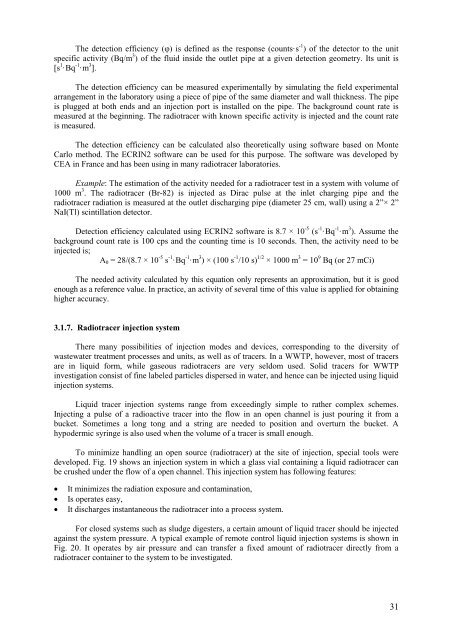Download file - Ayuntamiento de Zaragoza
Download file - Ayuntamiento de Zaragoza
Download file - Ayuntamiento de Zaragoza
You also want an ePaper? Increase the reach of your titles
YUMPU automatically turns print PDFs into web optimized ePapers that Google loves.
The <strong>de</strong>tection efficiency (ϕ) is <strong>de</strong>fined as the response (counts·s -1 ) of the <strong>de</strong>tector to the unitspecific activity (Bq/m 3 ) of the fluid insi<strong>de</strong> the outlet pipe at a given <strong>de</strong>tection geometry. Its unit is[s 1·Bq -1·m 3 ].The <strong>de</strong>tection efficiency can be measured experimentally by simulating the field experimentalarrangement in the laboratory using a piece of pipe of the same diameter and wall thickness. The pipeis plugged at both ends and an injection port is installed on the pipe. The background count rate ismeasured at the beginning. The radiotracer with known specific activity is injected and the count rateis measured.The <strong>de</strong>tection efficiency can be calculated also theoretically using software based on MonteCarlo method. The ECRIN2 software can be used for this purpose. The software was <strong>de</strong>veloped byCEA in France and has been using in many radiotracer laboratories.Example: The estimation of the activity nee<strong>de</strong>d for a radiotracer test in a system with volume of1000 m 3 . The radiotracer (Br-82) is injected as Dirac pulse at the inlet charging pipe and theradiotracer radiation is measured at the outlet discharging pipe (diameter 25 cm, wall) using a 2”× 2”NaI(Tl) scintillation <strong>de</strong>tector.Detection efficiency calculated using ECRIN2 software is 8.7 × 10 -5 (s -1·Bq -1·m 3 ). Assume thebackground count rate is 100 cps and the counting time is 10 seconds. Then, the activity need to beinjected is;A 0 = 28/(8.7 × 10 -5 s -1·Bq -1·m 3 ) × (100 s -1 /10 s) 1/2 × 1000 m 3 = 10 9 Bq (or 27 mCi)The nee<strong>de</strong>d activity calculated by this equation only represents an approximation, but it is goo<strong>de</strong>nough as a reference value. In practice, an activity of several time of this value is applied for obtaininghigher accuracy.3.1.7. Radiotracer injection systemThere many possibilities of injection mo<strong>de</strong>s and <strong>de</strong>vices, corresponding to the diversity ofwastewater treatment processes and units, as well as of tracers. In a WWTP, however, most of tracersare in liquid form, while gaseous radiotracers are very seldom used. Solid tracers for WWTPinvestigation consist of fine labeled particles dispersed in water, and hence can be injected using liquidinjection systems.Liquid tracer injection systems range from exceedingly simple to rather complex schemes.Injecting a pulse of a radioactive tracer into the flow in an open channel is just pouring it from abucket. Sometimes a long tong and a string are nee<strong>de</strong>d to position and overturn the bucket. Ahypo<strong>de</strong>rmic syringe is also used when the volume of a tracer is small enough.To minimize handling an open source (radiotracer) at the site of injection, special tools were<strong>de</strong>veloped. Fig. 19 shows an injection system in which a glass vial containing a liquid radiotracer canbe crushed un<strong>de</strong>r the flow of a open channel. This injection system has following features:• It minimizes the radiation exposure and contamination,• Is operates easy,• It discharges instantaneous the radiotracer into a process system.For closed systems such as sludge digesters, a certain amount of liquid tracer should be injectedagainst the system pressure. A typical example of remote control liquid injection systems is shown inFig. 20. It operates by air pressure and can transfer a fixed amount of radiotracer directly from aradiotracer container to the system to be investigated.31
















